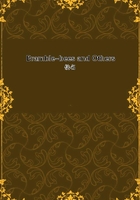
第58章 THE LEAF-CUTTERS.(7)
Incomplete though it be, this list tells us that the Megachiles do not have exclusive botanical tastes. Each species manages extremely well with several plants differing greatly in appearance. The first condition to be fulfilled by the shrub exploited is that it be near the nest. Frugal of her time, the Leaf-cutter declines to go on distant expeditions. Whenever I come upon a recent Megachile-nest, Iam not long in finding in the neighbourhood, without much searching, the tree or shrub from which the Bee has cut her pieces.
Another main condition is a fine and supple texture, especially for the first disks used in the lid and for the pieces which form the lining of the wallet. The rest, less carefully executed, allows of coarser stuff; but even then the piece must be flexible and lend itself to the cylindrical configuration of the tunnel. The leaves of the rock-roses, thick and roughly fluted, fulfil this condition unsatisfactorily, for which reason I see them occurring only at very rare intervals. The insect has gathered pieces of them by mistake and, not finding them good to use, has ceased to visit the unprofitable shrub. Stiffer still, the leaf of the holm-oak in its full maturity is never employed: the Silky Leaf-cutter uses it only in the young state and then in moderation; she can get her velvety pieces better from the vine. In the lilac-bushes so zealously exploited before my eyes by the Hare-footed Leaf-cutter occur a medley of different shrubs which, from their size and the lustre of their leaves, should apparently suit that sturdy pinker. They are the shrubby hare's-ear, the honeysuckle, the prickly butcher's-broom, the box. What magnificent disks ought to come from the hare's-ear and the honeysuckle! One could get an excellent piece, without further labour, by merely cutting the leaf-stalk of the box, as Megachile sericans does with her paliurus. The lilac-lover disdains them absolutely. For what reason? I fancy that she finds them too stiff.
Would she think differently if the lilac-bush were not there? Perhaps so.
In short, apart from the questions of texture and proximity to the nest, the Megachile's choice, it seems to me, must depend upon whether a particular shrub is plentiful or not. This would explain the lavish use of the vine, an object of widespread cultivation, and of the hawthorn and the wild briar, which form part of all our hedges. As these are to be found everywhere, the fact that the different Leaf-cutters make use of them is no reflection upon a host of equivalents varying according to the locality.
If we had to believe what people tell us about the effects of heredity, which is said to hand down from generation to generation, ever more firmly established, the individual habits of those who come before, the Megachiles of these parts, experienced in the local flora by the long training of the centuries, but complete novices in the presence of plants which their race encounters for the first time, ought to refuse as unusual and suspicious any exotic leaves, especially when they have at hand plenty of the leaves made familiar by hereditary custom. The question was deserving of separate study.
Two subjects of my observations, the Hare-footed and the Silvery Leaf-cutter, both of them inmates of my open-air laboratory, gave me a definite answer. Knowing the points frequented by the two Megachiles, I planted in their work-yard, overgrown with briar and lilac, two outlandish plants which seemed to me to fulfil the required conditions of suppleness of texture, namely, the ailantus, a native of Japan, and the Virginian physostegia. Events justified the selection: both Bees exploited the foreign flora with the same assiduity as the local flora, passing from the lilac to the ailantus, from the briar to the physostegia, leaving the one, going back to the other, without drawing distinctions between the known and the unknown. Inveterate habit could not have given greater certainty, greater ease to their scissors, though this was their first experience of such a material.
The Silvery Leaf-cutter lent herself to an even more conclusive test.
As she readily makes her nest in the reeds of my apparatus, I was able, up to a certain point, to create a landscape for her and select its vegetation myself. I therefore moved the reed-hive to a part of the enclosure stocked chiefly with rosemary, whose scanty foliage is not adapted for the Bee's work, and near the apparatus I arranged an exotic shrubbery in pots, including notably the smooth lopezia, from Mexico, and the long-fruited capsicum, an Indian annual. Finding close at hand the wherewithal to build her nest, the Leaf-cutter went no further afield. The lopezia suited her especially, so much so that almost the whole nest was composed of it. The rest had been gathered from the capsicum.